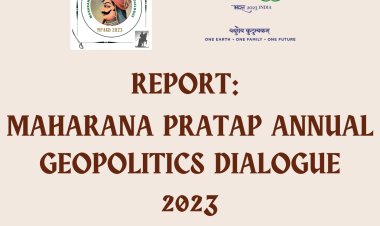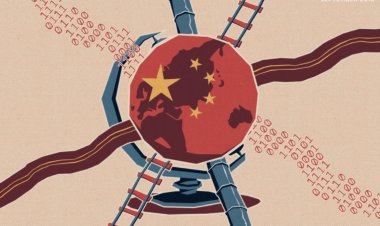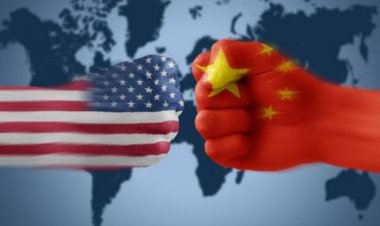Impact of Demographic Transition on International Relations
The world population is both steadily declining and aging, with the share of the young falling and that of the elderly rising. Findings from the IMHE study suggest that this decline in the numbers of working-age adults alone will reduce GDP growth rates that could result in major shifts in global economic power by the century's end.

Analysis
By Prerna Gandhi
Unlike popular notions, the world population is both steadily declining and aging, with the share of the young falling and that of the elderly rising. In 2020, a study by the Institute for Health Metrics and Evaluation (IHME) at the University of Washington's School of Medicine estimated that by 2100, 183 of 195 countries will have total fertility rates (TFR) below the replacement level of 2.1 births per woman. The IMHE study also predicts huge shifts in the global age structure, with an estimated 2.37 billion individuals to be over 65 years compared with 1.7 billion under 20 years by 2100. Professor Stein Emil Vollset, who served as the lead author for the IMHE study, categorically states "our findings suggest that the decline in the numbers of working-age adults alone will reduce GDP growth rates that could result in major shifts in global economic power by the century's end."
In international relations today, power is essentially divorced from population size. Productivity growth and technological developments have displaced the predominance of population size with respect to a country's economy or military. The principle of sovereign equality under the United Nations has assured an equal voice to countries irrespective of their population size. But that does not mean population weight is irrelevant. Countries small and large align to boost their political and security interests or to ensure access to resources and foreign markets through formal trade pacts. These regional and trading blocs redefine population memberships. With emerging new realities such as the rise of China, youth bulge in politically unstable countries, increasing protectionism, climate change, rapid urbanization, etc., the population has once again come to the forefront.
In a seminal paper in 1929, Warren S. Thompson had outlined the contours of the modern demographic transition theory by dividing countries into groups based on varying birth and death rates in their transition through the social and economic continuum. Different countries and regions are at varying stages of demographic transition. While developed countries leap ahead, even rising economies from Southeast Asia and Eastern Europe are set for significant aging from the third decade of the new millennium. In most other developing countries, the demographic dividend remains positive with working-age populations expected to increase in the coming decades. As a result, the driving gravity for the international order which had shifted over the centuries from the East to the West and had then begun to shift back to Asia would now shift from the North to the South.
In 1950, the combined population of the world's twenty largest countries stood at 1.9 billion people, or 74.4 percent of the global population. The top twenty countries at the time included eight European countries, the United States and Japan, which together accounted for a quarter (25.3 percent) of the global population. By 2015, though the demographic weight remained the same, the composition of the top twenty countries changed considerably with only two European countries, the United States and Japan remaining on the list. Their combined demographic weight dropped to 9.1 percent. Forecasts now suggest that by 2050, the Global North will only be represented by the United States, Russia, and Japan on that list (making up 6.5 percent of the global population) and that by the end of the century, only the United States will remain, accounting for 4 percent of the global population.
Thus, the Global North that was the main driver of the international liberal order and the global economy is increasingly turning into a demographic minority. The Global South, for its part, with its rapidly growing population, has made significant strides economically, but concerns remain whether it can shoulder the burden of global growth way forward. A crucial example is a case of the Middle East and North Africa (MENA) region where two-thirds of the people are under the age of 30. However, 1-in-3 young people are unemployed there. This population explosion in MENA is exacerbated by the realities of a post-oil age and rapid urbanization—where deficit infrastructure, rising crime, increasing radicalization, etc. further worsen regional instability.
China, whose rise, markedly defines today's international system faces a critical challenge from its demography. Chinese demographers believe that Beijing's population may start a natural negative growth from 2022, and Beijing's figures indicate that China's total population will soon start to decline, which may come before 2027. Some cities including Yangzhou, Wuxi in East China's Jiangsu Province, Fushun, and Shenyang in Northeast China's Liaoning Province already recorded negative natural population growth in 2020. In 2015, the one-child policy was discarded, but its most likely China will grow old before growing rich. The IMHE study quoted earlier too mentions that while China is set to replace the US as the world's largest economy in the coming decade, the US can be expected to reclaim the top spot due to China's deteriorating demographic dividend post-2050.
According to a Harvard Business Review article, the trajectory ahead for China bears tremendous similarities with Japan. Factors that have driven China's spectacular growth until now—a low baseline of productivity, to begin with, an excess supply of rural workers, and firms' ability to trade market access for productivity-enhancing foreign technology—have significantly weakened. Thus, when the working-age population shrinks, it will impact both revenues and China's GDP. The correlation between the decline in the working-age population and Japanese firms' leaving the Global 500 was 94%. China faces the same situation. According to a recent 2021 IMF report on average productivity across sectors that gages for overall economic efficiency, China's economy is only 30% as productive as the world's best-performing economies like the US, Japan, or Germany. The IMF firmly mentions that China's economic growth has weakened despite the strong recovery amidst the pandemic.
The Dual Circulation Policy that has been touted as dramatically reshaping the Chinese economy towards more domestic consumption, contradicts the fact that Chinese companies are already heavily reliant on domestic revenue for growth. The top three Chinese companies—State Grid Corporation of China, China Petrochemical Corporation, and China National Petroleum Corporation—generate more than 85% of their revenues domestically. Barring exceptions such as Huawei and Lenovo which see more than half their sales in foreign markets private tech giants Alibaba and Tencent generate 74% and 80%, respectively of their revenues inside China. In years ahead, as the Chinese economy shifts more from industry to services, overall productivity growth will slow further, as the industrial sector tends to have higher productivity.
While Indo-Pacific which has become the new centre of international order, faces significant demographic decline, a "Geriatric Peace" where population aging will influence foreign policies remains far-flung. For example, Japan which is undergoing an unprecedented demographic transformation has sought to replace manpower with technology for its security needs in times ahead. Japan has begun to develop unmanned, remote-controlled fighter aircraft capable of breakneck maneuvers that will be deployed as early as 2035. Japan's neighbours such as China, Taiwan, and South Korea also face demographic tightening, with South Korea suffering an ever-worse problem than Japan. South Korea has the world's lowest birth rate at 0.84 as of 2020. With fewer young males serving in South Korea's largely conscription-based military, the government has been steadily reducing the size of the military troops and evolved to manufacture its weapons through the country's modernization and military reforms since 2010. It has developed its robust defence industry and exports its products to many other nations. In 2019, South Korea became the 10th largest arms exporter according to SIPRI, making it the first time South Korea entered the top 10 list.
The principal tenets of Malthusian and neo-Malthusian thinking wherein a rapidly growing population is a threat to resources and the environment remains popular from the mid-twentieth century to the present. But research shows that climate change may trigger displacement and worsen living conditions or hamper return for refugees who have already been displaced. Limited natural resources, such as drinking water, are becoming even scarcer in many parts of the world such as Syria, Libya, Yemen, etc. In many conditions, climate change can act as a threat multiplier exacerbating existing tensions and adding to the potential for conflicts. Hazards resulting from the increasing intensity and frequency of extreme weather events are already causing an average of more than 20 million people to leave their homes and move to other areas in their countries each year.
Increasing inequalities and protectionism across the globe may not offer India the same opportunities that were capitalized on by China. This will require India to chart its path in the midst of the global demographic transition. India has an abundant supply of labour that will keep growing beyond 2050, a capital-labour ratio that desperately needs to be raised, and a level of human capital that can absorb new technologies much faster than its peers. But constraints on lending are creating significant dislocations at the moment, as India's banking sector is going through a massive consolidation in its public sector banks and a clean-up of bad debts in the aftermath of aggressive lending by its non-bank financial companies over the last few years. Further, India's internal collisions within its multi-party system as well as between the states and the federal government make a coordinated China-Esque policy of growth difficult to manage. A lot depends on how quickly and efficiently India's administration can reform and deregulate the economy.
Prerna Gandhi is an Associate Fellow with Vivekananda International Foundation, New Delhi.
Disclaimer: This article is the author's individual scholastic contribution and does not necessarily reflect the organisation's viewpoint.


















